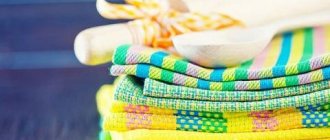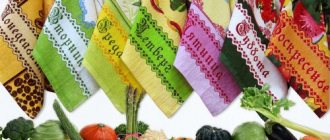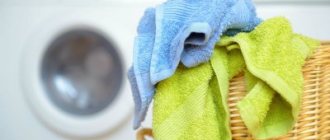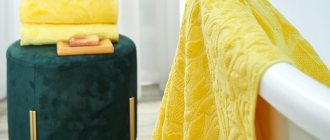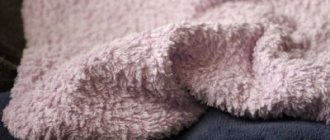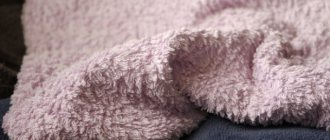In the kitchen, towels are needed to quickly dry dishes, work surfaces, or hands. As a result, home textiles quickly become dirty and lose their visual appeal. To clean it, various means are used, one of which is vegetable oil. Surprisingly, sunflower extract can not only stain the product, but also restore it to its former purity. There are several ways to whiten kitchen towels with vegetable oil.
Bleaching products with oil without boiling
The simplest recipe for cleaning light-colored home textiles involves the use of vegetable oil in combination with chemicals. In order to bleach 8-10 kitchen towels you will need:
- Boil approximately 5 liters of water.
- Add fine shavings of laundry soap (about 2-3 tablespoons) to boiling water.
- Stir the solution well.
- Pour in 1 tablespoon of vegetable oil and mix again.
Dry dirty towels are placed in an oil-soap mixture and soaked for 7-12 hours. Instead of crushed laundry soap, you can use dishwashing detergent or washing powder. To enhance the effect, you can add a little bleach or stain remover.
Vinegar
Another method, proven over the years and recommended by our grandmothers, is the use of vegetable oil along with table vinegar. This combination allows not only to return the products to their former whiteness, but also in a short time eliminates unpleasant odors from home textiles. How to whiten laundry using sunflower oil and vinegar:
- Boil 5 liters of water.
- Add one tablespoon of vinegar to boiling water and the same amount of sunflower extract.
- Add 50 grams of washing powder.
Additionally, you can add a tablespoon of bleach. Soak kitchen towels in the resulting mixture for about 7-12 hours. After this, home textiles are washed manually or in an automatic machine. For a snow-white shine, it is recommended to add a little lemon juice or citric acid when rinsing.
Potassium permangantsovka
To get rid of intense dirt, old stains and stubborn yellowness, pharmaceutical potassium permanganate, popularly called potassium permanganate, is perfect. These dark crystals, when dissolved in water, color the liquid a rich pink color. Potassium permanganate has a pronounced whitening and disinfecting effect, which means it is suitable not only for restoring whiteness, but also for sterilizing products. For the procedure you will need a solution of potassium permanganate, approximately 70 grams of soap shavings, 2 tablespoons of vegetable oil and 8-10 liters of boiling water.
Pour soap shavings into hot water and stir until the soap is completely dissolved. Then pour in the bright pink liquid and shake again. Lastly, add a few tablespoons of vegetable oil to the mixture. Place kitchen towels into the resulting solution and leave for a while. It is best to soak textiles for 8-12 hours, for example, overnight. After the specified time, the towels are washed in the usual way, dried and ironed.
Mustard
Mustard powder is an ally in the fight against the most difficult stains. This affordable budget product is suitable for cleaning stains from synthetic and natural fabrics, eliminating unpleasant odors and returning radiant whiteness in a short time. For a noticeable result, you will need about 8-10 liters of water, 1 tablespoon of powdered mustard, several tablespoons of vegetable oil.
The water should first be boiled. If the pollution is fresh and not too pronounced, then it is allowed to heat the water to 60-70 degrees. Next, add mustard powder into the basin and mix thoroughly. Then pour in vegetable oil and shake again. For complete dissolution, it is best to use a special silicone spatula or wooden stick. If things have an unpleasant odor, then add a couple of tablespoons of table vinegar. Home textiles are soaked for 8-12 hours, after which they are washed in a suitable manner.
How to properly wash items with oil
Proper use of sunflower extract allows you to get rid of even old contaminants. In addition, this effective method allows you to return the product to its former whiteness. It is important that the use of vegetable oil is suitable for any type of home textiles: waffle towels, linen, terry. To achieve the best result, it is recommended to follow the following algorithm:
- pre-sort products;
- soak kitchen towels;
- remove stains;
- wash in the usual way;
- dry and iron home textiles.
An important step in washing is sorting the items. The color and texture of textiles are taken into account. Bright towels are washed separately from white ones, synthetic ones - separately from products made from natural materials. To remove dirt from the fibers faster, you should first soak the item in warm water. You can speed up the process of softening stains by using dishwashing detergents, liquid or laundry soap.
Next, vegetable oil is used to completely clean the product and return it to its bright white color. After carrying out all the necessary manipulations, the product is washed in an automatic machine or by hand. In special cases, very dirty household textiles can be boiled with bleach. You can dry the towel both outdoors and indoors. After this, the item must be ironed.
It is important to know that vegetable oil is not used separately; it is not capable of removing contaminants. However, in combination with some other components, it perfectly softens stains and helps wash them out of the fibers.
Features of using vegetable oil
Whitening clothes at home with sunflower oil has certain nuances.
Table No. 1. Features of using the technique
| Nuance | More details |
| Maintaining sequence | Washing powder and other chemicals are first dissolved in hot water, and only then oil is added. Otherwise, a film will form on the water, reducing the effectiveness of the technique. |
| When using vinegar, do not use baking soda instead of commercial dry bleach. | The combination will cause the liquid to foam and lose its whitening effect. |
| Repetition | In some cases, at least 3-4 procedures are required to achieve results. |
| Processing of dry products | It is better to place especially dirty textiles in the solution dry. A wet product will absorb less liquid. |
It should be remembered that in this way you can bleach almost any light-colored items made from natural fabrics. For synthetic clothing and home textiles, the use of vegetable oil in combination with other components is not as effective.
Useful tips
To whiten towels as effectively as possible, we recommend:
- Add the oil component only after the other ingredients are completely dissolved in water. If this rule is not followed, the oily film will slow down the dissolution process and also reduce the effectiveness of other components.
- If you use a recipe with vinegar, it is not recommended to replace the bleach with soda: the resulting mixture will foam strongly and overflow the edge of the container.
- Place only dry items for processing - moisture will prevent the dirt from breaking down, and the cleaning will be of poor quality.
Washing home textiles with oil and bleach
If you don’t want to bother with boiling, then you can resort to proven bleaches. The combination of ready-made household chemicals with sunflower extract gives excellent results in cleaning textiles. Bleaching towels with vegetable oil and bleach involves certain steps. In particular:
- you need to take 5-7 liters of hot water;
- dilute a couple of tablespoons of bleach in the liquid;
- add a little soap shavings or powder;
- pour in 2-3 tablespoons of vegetable oil;
- mix everything thoroughly;
- then wash the items in a machine or by hand, dry and iron.
The products are soaked in the resulting solution for a couple of hours. Dry bleaching agents are best. Even the simplest ones - Swan, Persol - give good results. A list of popular effective products used in conjunction with vegetable oil is given in the table below.
We recommend:
How to remove tar from clothes
Table No. 2. The best household bleaches for kitchen towels
| Name | About bleach |
| Eared nanny | An inexpensive powder that gently removes dirt. Does not cause allergies. |
| Ace OxyMagic | Works great on stains and gray fabrics. |
| Vanish OxyAction | Combines stain remover and bleach. Carefully deals with stains, suitable not only for light-colored items, but also for colored items. |
It is important to know that prolonged soaking in bleach can cause damage to the integrity of the fibers or irreversible yellowing of home textiles. The instructions for using household chemicals should be strictly followed.
Soaking towels
Preliminary soaking of kitchen textiles in a solution of water, oil and a mixture of degreasers greatly simplifies the removal of contaminants from the fabric.
General rules for soaking:
- Place things of similar color into one container.
- White should be processed separately from colored or embroidered.
- Preheating the soaking water facilitates the dissolution of the active substances themselves, added components and contaminants.
- To improve the efficiency of the process, the towels are kept in the solution for 3-5 hours or left overnight.
Using vegetable oil with washing powder
This technique came to Russia from the Land of the Rising Sun. The traditional Japanese combination of sunflower oil and laundry detergent produced amazing results. The mixture effectively removed stains and combated yellowness. It should be noted right away that this recipe is only suitable for hand washing. It is strictly forbidden to use a combination of oil and powder to clean home textiles in an automatic machine. The mixture can cause irreparable harm to equipment. The whitening recipe is very similar to the previously discussed methods; it involves following a certain algorithm. Exactly:
- you should take 8-10 liters of very hot water;
- add 50-70 grams of hand washing powder to the liquid;
- pour in a few tablespoons of vegetable oil.
Severe stains are pre-washed with laundry soap. Dry kitchen towels are soaked in the resulting soap solution. The latter is thoroughly kneaded with a silicone spatula. Things are left overnight, then rinsed. It is best to alternate hot water with cold. Rinsed towels can be washed by hand or placed in a washing machine. To carry out the procedure, use a standard amount of powder. It is allowed to add conditioner to scent home textiles. For automatic cleaning, set the following parameters:
- Washing mode “Cotton”, “Synthetics”, “Sport”, “Intensive wash”.
- You can select Extra Rinse.
- Set the temperature in the range from 40 to 60 degrees.
Silicate glue
To remove the most stubborn stains on kitchen towels made of natural fabric, you can use regular silicate or office glue. To do this, dissolve soap shavings from 1 piece of laundry soap in 10 liters, add 1 tbsp. spoon of silicate glue. It is necessary to boil the towels for 30-60 minutes. Then they are loaded into the rinsing machine and you get perfectly clean and fresh laundry.
Silicate glue is suitable for washing very soiled items.
Oil bleaching after washing
The method is suitable for those who were unable to remove stubborn stains and restore the whiteness of home textiles during manual or machine cleaning. For high-quality bleaching, products must be dry. To whiten kitchen towels after washing, you can use one of the following recipes:
- combination of sunflower oil and soda;
- use in conjunction with hydrogen peroxide;
- the use of citric acid and vegetable oil.
Baking soda is used for bleaching. It literally pushes dirt out of the fibers. Soda is effective against yellowness and grayness, especially in combination with vegetable oil. To clean kitchen towels, dissolve 50 grams of baking soda in very hot water. Add a few tablespoons of sunflower oil to the mixture and stir until smooth. Then immerse home textiles in the liquid for a couple of hours. After rinse the products, squeeze thoroughly and dry. Additionally, you can use vinegar and conditioner.
Hydrogen peroxide is great for removing yellowness from any natural fabrics. A 3 percent solution is added to 5-7 liters of water heated to 60 degrees. Pour sunflower oil into the water and leave for 5-6 hours. After the specified time has passed, the towels are rinsed manually or by selecting the “Rinse” mode on an automatic machine. The method is not suitable for removing dirt from synthetic and colored items. Bright fabrics may lose color. Citric acid is used in the same way. It does not remove stains, but effectively whitens towels.
Rate this post
General recommendations
Whitening kitchen towels will be faster and much more effective if you initially apply some recommendations. To reduce the negative impact of bleaches from the store and boiling, you should listen to the following advice:
- In the household you need to have several sets of kitchen towels; if they are very dirty, you can immediately get the next one.
- Do not rush to wash until the products you use are visually dirty. With minimal contamination, the towel can be used for three days in a row, or even for a whole week.
- Be sure to iron the washed and dried towel; its appearance will be more neat and cleanliness will remain for a longer period.
- To remove greasy marks and other contaminants on kitchen surfaces, use disposable rags and napkins. If necessary, they can be thrown away immediately after use.
- It is better to blot and dry vegetables and fruits with paper towels; they are also better for removing greasy marks.
- Remove moisture from washed hands with a cloth towel.
Advice! You should not use terry types of towels for the kitchen; they take longer to dry, which contributes to the development of harmful microflora and an unpleasant smell in the kitchen. Such products will be washed in the same way as regular linen ones.
The best option for kitchen towels would be waffle cotton ones. The fibers have excellent absorbent characteristics; this type of laundry is bleached using chlorine-containing substances and traditional methods.
To prevent strong marks, it is necessary to wash kitchen towels more often using various auxiliary products, including sunflower oil.


